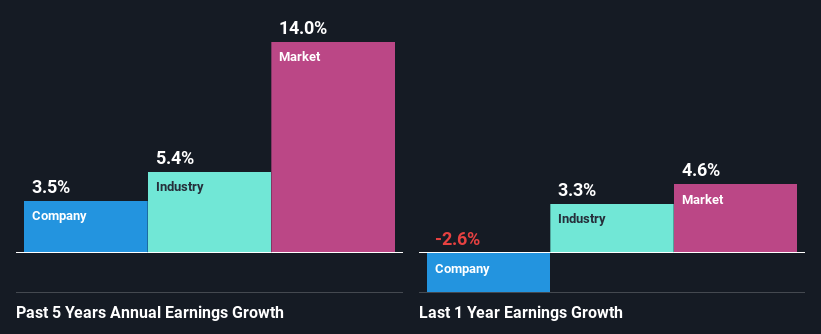Is Discovery Limited's (JSE:DSY) Recent Price Movement Underpinned By Its Weak Fundamentals?
Discovery (JSE:DSY) has had a rough three months with its share price down 19%. It is possible that the markets have ignored the company's differing financials and decided to lean-in to the negative sentiment. Long-term fundamentals are usually what drive market outcomes, so it's worth paying close attention. Specifically, we decided to study Discovery's ROE in this article.
Return on Equity or ROE is a test of how effectively a company is growing its value and managing investors’ money. In short, ROE shows the profit each dollar generates with respect to its shareholder investments.
Check out our latest analysis for Discovery
How Do You Calculate Return On Equity?
The formula for ROE is:
Return on Equity = Net Profit (from continuing operations) ÷ Shareholders' Equity
So, based on the above formula, the ROE for Discovery is:
10% = R5.4b ÷ R52b (Based on the trailing twelve months to December 2023).
The 'return' refers to a company's earnings over the last year. One way to conceptualize this is that for each ZAR1 of shareholders' capital it has, the company made ZAR0.10 in profit.
What Is The Relationship Between ROE And Earnings Growth?
We have already established that ROE serves as an efficient profit-generating gauge for a company's future earnings. We now need to evaluate how much profit the company reinvests or "retains" for future growth which then gives us an idea about the growth potential of the company. Assuming everything else remains unchanged, the higher the ROE and profit retention, the higher the growth rate of a company compared to companies that don't necessarily bear these characteristics.
A Side By Side comparison of Discovery's Earnings Growth And 10% ROE
As you can see, Discovery's ROE looks pretty weak. Even compared to the average industry ROE of 14%, the company's ROE is quite dismal. Therefore, the disappointing ROE therefore provides a background to Discovery's very little net income growth of 3.5% over the past five years.
As a next step, we compared Discovery's net income growth with the industry and were disappointed to see that the company's growth is lower than the industry average growth of 5.4% in the same period.
Earnings growth is an important metric to consider when valuing a stock. It’s important for an investor to know whether the market has priced in the company's expected earnings growth (or decline). Doing so will help them establish if the stock's future looks promising or ominous. Is Discovery fairly valued compared to other companies? These 3 valuation measures might help you decide.
Is Discovery Making Efficient Use Of Its Profits?
A low three-year median payout ratio of 14% (implying that the company retains the remaining 86% of its income) suggests that Discovery is retaining most of its profits. This should be reflected in its earnings growth number, but that's not the case. Therefore, there might be some other reasons to explain the lack in that respect. For example, the business could be in decline.
Moreover, Discovery has been paying dividends for at least ten years or more suggesting that management must have perceived that the shareholders prefer dividends over earnings growth. Our latest analyst data shows that the future payout ratio of the company over the next three years is expected to be approximately 16%. However, Discovery's ROE is predicted to rise to 14% despite there being no anticipated change in its payout ratio.
Summary
In total, we're a bit ambivalent about Discovery's performance. Even though it appears to be retaining most of its profits, given the low ROE, investors may not be benefitting from all that reinvestment after all. The low earnings growth suggests our theory correct. With that said, the latest industry analyst forecasts reveal that the company's earnings are expected to accelerate. To know more about the latest analysts predictions for the company, check out this visualization of analyst forecasts for the company.
Have feedback on this article? Concerned about the content? Get in touch with us directly. Alternatively, email editorial-team (at) simplywallst.com.
This article by Simply Wall St is general in nature. We provide commentary based on historical data and analyst forecasts only using an unbiased methodology and our articles are not intended to be financial advice. It does not constitute a recommendation to buy or sell any stock, and does not take account of your objectives, or your financial situation. We aim to bring you long-term focused analysis driven by fundamental data. Note that our analysis may not factor in the latest price-sensitive company announcements or qualitative material. Simply Wall St has no position in any stocks mentioned.

 Yahoo Finance
Yahoo Finance 
